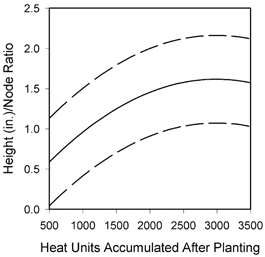Plant growth is promoted by sufficient sunshine, temperature, water, and nutrients (particularly nitrogen). When conditions and management are appropriate each of these factors are provided in adequate amounts to cotton fields. Thus, vigorous plant growth can be very common in mid- to late- season stages of development in Arizona. Managing the balance between vegetative and reproductive growth is a very important part of cotton’s productivity. Plant growth regulators (PGRs) can help manage this balance. A very common and popular PGR used in cotton production is mepiquat chloride (MC), often referred to by a product name PIXtm. A considerable amount of research has been conducted in Arizona to evaluate MC applications on cotton in terms growth, development, and yield. We have recently analyzed the cumulative information obtained from over 30 field experiments that were conducted in many cotton producing areas in Arizona over the past 13 seasons. This article provides a brief summary of these results. A more detailed description of these analyses is published in the 2000 University of Arizona Cotton Report, Series P-121 (p. 72-88).
Of the many factors that are important to consider in evaluating a cotton crop, fruit retention (FR) and an assessment of plant vigor (HNR) are among the most critical. Baselines developed in Arizona can be used to reference FR and HNR conditions for any field based on heat unit accumulations after planting (HUAP, 86/55 oF thresholds) (Figure 1). Recommendations and guidelines from the University of Arizona regarding MC use (PIXtm) are summarized in several bulletins (i.e. J.C. Silvertooth and E.R. Norton. 1998. Publication No. AZ 1049, Cooperative Extension, College of Agriculture, University of Arizona).
The information in Tables 1 and 2 outlines the general response patterns that were revealed by the analyses developed in Arizona over the past 13 seasons. Conclusions that can be drawn from these results include: 1) the probability of a positive yield response to MC applications is very low, 2) the probability of realizing a positive yield response from MC applications can be improved by use of simple plant measurements to estimate vigor (HNR) and fruit load (FR), and 3) MC applications should be avoided on crops that have low vigor relative to the established baselines for HNRs in Arizona. It is also important to point out that plant height and general plant architecture was significantly reduced from most MC treatments even if yield was not significantly affected. Therefore, crop monitoring and evaluation are very important to management decisions regarding MC and efforts to maintain a good balance of plant growth.
University of Arizona Extension bulletins, Cotton Reports, and other cotton related information are available at the Arizona Crop Information Site. The URL for this site is: http://cals.arizona.edu/crops/
Figure 1. Height to node ratio and percent fruit retention baselines for Arizona grown cotton varieties.


Table 1. Yield response distribution among mepiquat chloride experiments, AZ, 1987-1999.
|
Yield Response |
% of Cases |
|
Positive |
15
|
|
Negative |
17 |
|
None |
68
|
Yield response in relation to untreated check. P< 0.05, n = 148
Table 2. Yield responses and relationships to crop condition at the time of mepiquat chloride application, AZ, 1987-1999.
| Positive Yield Response | Negative Yield Response | ||
|
Height to Node Ratio |
Fruit Retention |
Height to Node Ratio |
Fruit Retention |
|
100 % above baselines |
61 % above baselines |
100 % below baselines |
100 % above baselines |
|
39% below baselines |
|||
Issued in furtherance of Cooperative Extension work, acts of May 8 and June 30, 1914, in cooperation with the U.S. Department of Agriculture, James A. Christenson, Director Cooperative Extension, College of Agriculture and Life Sciences, The University of Arizona.
The University of Arizona is an equal opportunity, affirmative action institution. The University does not discriminate on the basis of race, color, religion, sex, national origin, age, disability, veteran status, or sexual orientation in its programs and activities.
Any products, services, or organizations that are
mentioned, shown, or indirectly implied in this web document do not imply
endorsement by The University of Arizona.
Information provided by Jeffrey C. Silvertooth, silver@ag.arizona.edu
Extension Agronomist - Cotton, College of Agriculture, The University of Arizona.
Material written 30 June 2000.
Home | Cotton | Advisories
document located at: http://cals.arizona.edu/crops/cotton/comments/june2000cc.html
Copyright © 2001 University of Arizona,
College of Agriculture and Life Sciences
Webmaster: Al Fournier (acis@ag.arizona.edu)